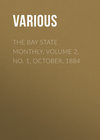Loe raamatut: «The Bay State Monthly. Volume 2, No. 1, October, 1884», lehekülg 8
OUR NATIONAL CEMETERIES
By Charles Cowley, LL.D
There are circumstances generally attending the death of the soldier or the sailor, whether on battle-field or gun-deck, whether in the captives' prison, the cockpit, or the field-hospital, which touch our sensibilities far more deeply than any circumstances which usually attend the death of men of any other class; moving within us mingled emotions of pathos and pity, of mystery and awe.
"There is a tear for all that die,
A mourner o'er the humblest grave;
But nations swell the funeral cry,
And freedom weeps above the brave;
"For them is sorrow's purest sigh,
O'er ocean's heaving bosom sent;
In vain their bones unburied lie,—
All earth becomes their monument.
"A tomb is their's on every page;
An epitaph on every tongue;
The present hours, the future age,
Nor them bewail, to them belong.
"A theme to crowds that knew them not,
Lamented by admiring foes,
Who would not share their glorious lot?
Who would not die the death they chose?"
A similar halo invests our National Cemeteries—which are the most permanent mementos of our sanguinary Civil War.
Nature labors diligently to cover up her scars. Most of the battle-fields of the Rebellion now show growths of use and beauty. Many of the structures of that great conflict have already ceased to be. Some of them have been swept away by the winds or overgrown with weeds; others, like Fort Wagner, have been washed away by the waves. But neither winds nor waves are likely to disturb the monuments or the cemeteries of our soldiers and sailors. Where they were placed, there they remain; "and there they will remain forever."
The seventy-eight National Cemeteries distributed over the country contain the remains of three hundred and eighteen thousand four hundred and fifty-five men, classed as follows: known, 170,960; unknown, 147,495; total, 318,455. And these are not half of those whose deaths are attributable to their service in the armies and navies of the United States and the Confederate States, who are buried in all sections of the Union and in foreign lands.
In some of these cemeteries, as at Gettysburg, Antietam, City Point, Winchester, Marietta, Woodlawn, Hampton, and Beaufort, by means of public appropriations and private subscriptions, statues and other monuments have at different times been erected; and many others doubtless will be erected in them hereafter. Some of them are in secluded situations, where for many mites the population is sparse, and the few people that live near them cherish tenderer recollections of the "Lost Cause" than of that which finally won. But such of them as are contiguous to cities are places of interest to more or less of the neighboring population; and, in some of them, there are commemorative services upon Memorial Days.
These cemeteries have many features in common; and much that may be said of one of them may also be said of the others—merely changing the names.
It happened to the present writer to visit the National Cemetery at Beaufort, South Carolina, to deliver an oration on Memorial Day, 1881, in the midst of ten thousand graves of the soldiers and sailors of the department of the South and South Atlantic blockading squadron. The dead interred in these thirty acres of graves are: known, 4,748, unknown, 4,493; total, 9,241. Among the trees planted in this cemetery is a willow, grown from a branch of the historic tree which once overshadowed the grave of Napoleon at St. Helena.
Generals Thomas W. Sherman and John G. Foster, who commanded that department, and Admirals Dupont and Dahlgren, who commanded that squadron, all died in their Northern homes since the peace, and their graves are not to be looked for here. The same may be said of hundreds of military and naval officers who performed valuable services on these shores and along these coasts, and have since "passed over to the great majority."
That neither General Strong nor General Schimmelfennig is buried here might be accounted for by the fact that, though they died by reason of their having served in this department, they died at the North. But even General Mitchell, whose flag of command was last unfurled in this department, who died in Beaufort, and was originally buried under the sycamores of the Episcopal churchyard, now sleeps in the shades of Greenwood, and not (as he would probably have preferred, could he have foreseen this cemetery) among the brave men whom he commanded.
The best known names among those here buried (to use a pardonable Hibernianism) are among the "unknown." For here, as we may believe, in unknown graves, rest the remains of Colonel Robert G. Shaw, of the Fifty-fourth Massachusetts (colored), Colonel Haldimand S. Putnam, of the Seventh New Hampshire, Lieutenant-Colonel James M. Green, of the Forty-eighth New York, and many other gallant officers and men who were killed in the assault on Fort Wagner, July 18, 1863, and who were first buried by the Confederates in the sands of Morris Island.
Many a Northern college is represented here. Among those to whom tablets have been erected in the Memorial Hall of Harvard University, who are buried here, besides Colonel Shaw, are Captains Winthrop P. Boynton and William D. Crane, who were killed at Honey Hill, November 30, 1864; and Captain Cabot J. Russell, who fell with Shaw at Fort Wagner. Yet these are but the beginning of the list of the sons of Massachusetts who rest in this "garden of graves."
Among the many gallant men of the navy buried here is Acting-Master Charles W. Howard, of the ironclad steam-frigate New Ironsides, whom Lieutentant Glassell shot during his bold attempt to blow up the New Ironsides with the torpedo steamer David, October 5, 1863. Another is Thomas Jackson, coxswain of the Wabash, the beau ideal of an American sailor, who was killed in the battle of Port Royal, November 7, 1861.
Death, like a true democrat, levels all distinctions. Still, it may be mentioned that Lieutenant-Colonel William N. Reed, who was mortally wounded at Olustee while in command of the Thirty-fifth United States colored troops, February 20, 1864, was, while living, the highest officer in rank, whose grave is known here. Other gallant officers, killed at Olustee, are buried near him. Among these, probably, is Colonel Charles W. Fribley, of the Eighth United States colored troops; though he may be still sleeping beneath the sighing pines of Olustee.
As far as practicable, all Federal soldiers and sailors buried along the seaboard of South Carolina, Georgia, and Florida, have been removed to Beaufort Cemetery; and, as Governor Alexander H. Bullock said: "Wherever they offered up their lives, amid the thunder of battle, or on the exhausting march, in victory or in defeat, in hospital or in prison, officers and privates, soldiers and sailors, patriots all, they fell like the beauty of Israel on their high places, burying all distinctions of rank in the august equality of death."
One section of the cemetery is devoted to the Confederates. There are more than a hundred of these, including several commissioned officers; and on Memorial Days the same ladies who decorate the graves of the Federals decorate also in the same manner the graves of the Confederates; recognizing that, though in life they were arrayed as mortal enemies, they are now reconciled in "the awful but kindly brotherhood of death." Sir Walter Scott enjoins:—
"Speak not for those a separate doom,
Whom fate made brothers in the tomb."
And One infinitely greater than Sir Walter has inculcated still loftier sentiments.
Among the graves to which the attention of the writer was particularly attracted was that of Charley –, a boy of Colonel Putnam's regiment, who had now been dead more years than he had lived. His parents, living on the shores of Lake Winnipiseogee, and walking daily over the paths which he had often trod, had plucked the earliest flower of their northern clime and sent it to the superintendent of the cemetery, to be planted at Charley's grave. The burning sun of South Carolina had not spared that flower; but something of it still remained. Its mute eloquence spoke to the heart of the tender recollections of a father and of a mother's undying love. How truly does Wordsworth say,—
"The meanest flower that blows can give
Thoughts that do often lie too deep for tears."
For us who have survived the perils of battle and the far more fatal diseases that wasted our forces, and for all who cherish the memory of these dead, it will always be a consoling thought that the Federal government has done so much to provide honorable sepulture for those who fell in defence of the Union. We can all appreciate Lord Byron's lament for the great Florentine poet and patriot;—
"Ungrateful Florence! Dante sleeps afar,
Like Scipio, buried by the upbraiding shore."
But we can have no such regret for our lost comrades, buried not upon a foreign, nor upon an unfriendly shore, but in the bosom of the soil which their blood redeemed. Sacred is the tear that is shed for the unreturning brave.
"'T is the tear through many a long day wept,
'T is life's whole path o'ershaded;
'T is the one remembrance, fondly kept,
When all lighter griefs have faded."










